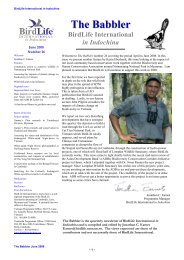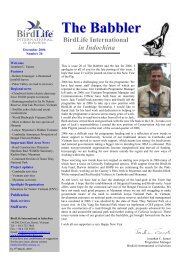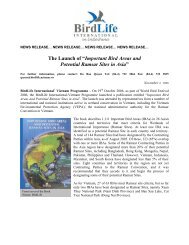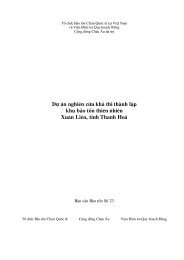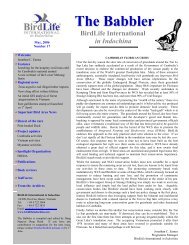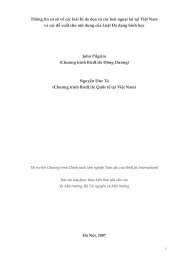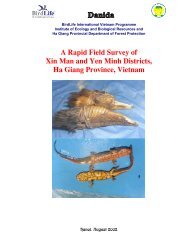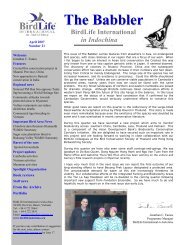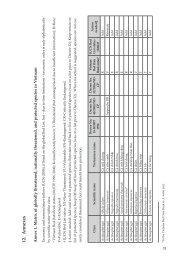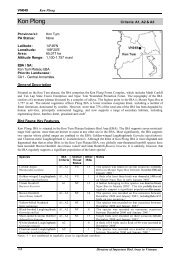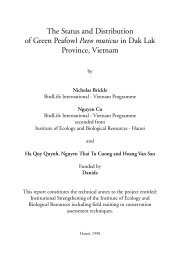Bird Life Tieng Anh-01.qxd - Birdlife International in Indochina
Bird Life Tieng Anh-01.qxd - Birdlife International in Indochina
Bird Life Tieng Anh-01.qxd - Birdlife International in Indochina
You also want an ePaper? Increase the reach of your titles
YUMPU automatically turns print PDFs into web optimized ePapers that Google loves.
Executive Summary<br />
In 1996, work<strong>in</strong>g with the Forest Inventory and Plann<strong>in</strong>g Institute (FIPI) and funded by Danida, the<br />
<strong>Bird</strong><strong>Life</strong> <strong>International</strong> Vietnam Programme conducted a comprehensive evaluation of key coastal zone<br />
wetland sites <strong>in</strong> the Red River Delta and identified seven priority sites for wetland conservation <strong>in</strong> this<br />
biodiversity-rich region of <strong>in</strong>ternational importance. In 2001, six sites <strong>in</strong> the coastal zone of the Red<br />
River Delta were identified by <strong>Bird</strong><strong>Life</strong> <strong>International</strong> as Important <strong>Bird</strong> Areas (IBAs) under <strong>in</strong>ternationally<br />
recognised criteria: An Hai, Tien Lang (Hai Phong city), Thai Thuy, Tien Hai (Thai B<strong>in</strong>h prov<strong>in</strong>ce),<br />
Xuan Thuy and Nghia Hung (Nam D<strong>in</strong>h prov<strong>in</strong>ce).<br />
S<strong>in</strong>ce 1996 there have been no comprehensive surveys of the six wetland IBAs <strong>in</strong> the Red River Delta.<br />
This study, funded by the Keidanren Nature Conservation Fund (KNCF), aimed to address this lack<br />
of <strong>in</strong>formation on the current status of these critical sites.<br />
The specific objectives of the study were to:<br />
• Collect and review all available literature on the key wetland sites <strong>in</strong> the Red River Delta, identify<br />
gaps <strong>in</strong> <strong>in</strong>formation and propose additional surveys as required;<br />
• Collect data on the status and distribution of bird species at selected sites <strong>in</strong> the Red River Delta,<br />
particularly globally threatened and congregatory species;<br />
Collect data on the status of wetland habitats at each site; and<br />
•<br />
•<br />
Assess threats to bird diversity at each site, and formulate appropriate conservation<br />
recommendations.<br />
The coastal zone of the Red River Delta supports large <strong>in</strong>shore fishery and aquaculture <strong>in</strong>dustries which<br />
are dependent on the ma<strong>in</strong>tenance of the ecological <strong>in</strong>tegrity of the mangrove forests, <strong>in</strong>tertidal areas<br />
and associated habitats. As a result of an <strong>in</strong>creas<strong>in</strong>g human population coupled with economic growth,<br />
utilisation of natural resources has become <strong>in</strong>tensive throughout the coastal zone and may no longer<br />
be susta<strong>in</strong>able. Project fieldwork was implemented dur<strong>in</strong>g a five-month period between November 2005<br />
and March 2006. As well as comprehensive counts of waterbirds at each site, other bird species present<br />
were noted and data obta<strong>in</strong>ed on the key flora, on socio-economic aspects of each site, on current levels<br />
of resource- and land-use by local communities, and on the levels of threats at each locality.<br />
The project confirmed the s<strong>in</strong>gle most important site for conservation <strong>in</strong> the Red River Delta is Xuan<br />
Thuy National Park, followed <strong>in</strong> order by Thai Thuy, Tien Hai, Tien Lang, Nghia Hung and An Hai.<br />
With an <strong>in</strong>creas<strong>in</strong>g human population and over-exploitation of natural resources, it was predictable that<br />
sites without appropriate management would have fared badly s<strong>in</strong>ce 1996. Nevertheless, it was particularly<br />
disappo<strong>in</strong>t<strong>in</strong>g to see the decl<strong>in</strong>e <strong>in</strong> Nghia Hung. In 1996, <strong>Bird</strong><strong>Life</strong> recommended this site was worthy<br />
of designation under the Ramsar Convention; today it would fail to meet the relevant criteria. Like other<br />
sites <strong>in</strong> the Red River Delta, it has ma<strong>in</strong>ly suffered because of over-hunt<strong>in</strong>g and habitat loss caused by<br />
over-exploitation of its natural resources.<br />
Specific conservation management recommendations for each IBA are presented. However, address<strong>in</strong>g<br />
the major issues of cont<strong>in</strong>u<strong>in</strong>g habitat loss and over-hunt<strong>in</strong>g are urgent conservation priorities if the<br />
globally important biodiversity <strong>in</strong> the Red River Delta is to be conserved for future generations.<br />
The Red River Delta is a vital location for biodiversity conservation <strong>in</strong> Indoch<strong>in</strong>a. It is of paramount<br />
importance for migratory waterbirds visit<strong>in</strong>g and pass<strong>in</strong>g through the region from north-east Asia and<br />
Siberia to Australasia, and there is an <strong>in</strong>ternational obligation to ma<strong>in</strong>ta<strong>in</strong> its <strong>in</strong>tegrity and habitat quality.<br />
iii




